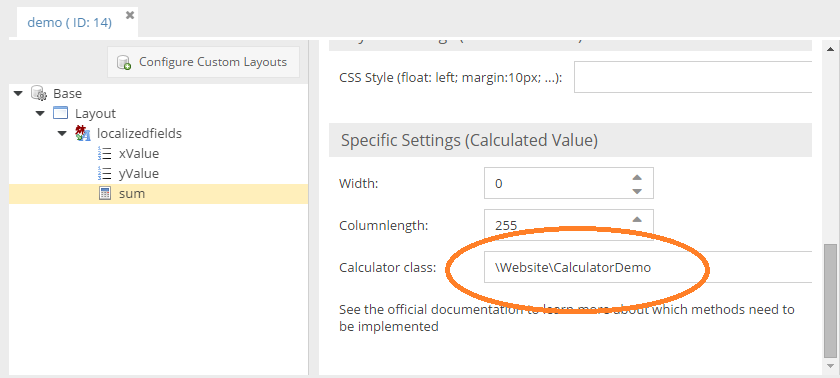Calculated Value Datatype
General
The calculated-value datatype allows you to calculate attributes based on the value of various other attributes. The only data stored is the one in the object's query tables.
Let's have a closer look by walking through a simple example.
Let's suppose we have a very simple class with 2 number fields called xValue and yValue and a calculated-value field
called sum placed inside a localizedfields container.

The first step is to provide a PHP calculator class implementing at least one static method which computes the result
for the sum field. An example is shown below.
The arguments passed into this method is the Pimcore object and the contextual information telling you which calculated-value field is affected and where it is located it.
The extent of information differs on which datatype is the owner of the calculated-value field (localizedfield, object brick etc.). The details are documented below.
namespace Website;
use Pimcore\Model\DataObject\Concrete;
class CalculatorDemo
{
/**
* @param $object Concrete
* @param $context \Pimcore\Model\DataObject\Data\CalculatedValue
* @return string
*/
public static function compute($object, $context) {
if ($context->getFieldname() == "sum") {
$language = $context->getPosition();
return $object->getXValue($language) + $object->getYValue($language);
} else {
\Logger::error("unknown field");
}
}
}
As we see here, the calculator class sums up the x and y values from the corresponding language tab.
It is also possible to provide a different representation for edit mode by providing a second (optional) implementation just for this purpose. An example would be:
/**
* @param $object
* @param $context \Pimcore\Model\DataObject\Data\CalculatedValue
* @return string
*/
public static function getCalculatedValueForEditMode($object, $context) {
$language = $context->getPosition();
$result = $object->getXValue($language) . " + " . $object->getYValue($language) . " = " . self::compute($object, $context);
return $result;
}
The visual outcome would be as follows:

Working with PHP API
Getter methods on the object class are generated as usual. The code to retrieve the values would then be:
$object = Object_Abstract::getByPath("/demoobject");
$valueDe = $object->getSum("de"); // => 38
$valueEn = $object->getSum("en"); // => 11
Context Information for Calculation Class
As said before, the richness of the context information depends on the location of the calculated-value field.
Object (top-level)
| Name | Description |
|---|---|
| ownerType | "object" |
| fieldName | the name of the calcuated-value field (e.g. sum) |
Localizedfields
| Name | Description | |
|---|---|---|
| position | the language ("en", "de", ...) | |
| ownerType | "localizedfield" |
|
| ownerName | the name of the localized field ("localizedfields") |
Objectbricks
| Name | Description |
|---|---|
| ownerType | "objectbrick" |
| ownerName | the name of the objectbrick field inside the object |
| fieldName | the name of the attribute inside the brick |
| index | the name of the brick |
| keyDefinition | the calculated-value field definition |
Fieldcollections
| Name | Description |
|---|---|
| ownerType | "fieldcollection" |
| ownerName | the name of the fieldcollection attribute |
| fieldName | the name of the attribute inside the fieldcollection |
| index | the index of the fieldcollection item |
| keyDefinition | the calculated-value field definition |
Classification Store
| Name | Description |
|---|---|
| ownerType | "classificationstore" |
| ownerName | the name of the fieldcollection attribute |
| fieldName | the name of the attribute inside the fieldcollection |
| position | the language |
| groupId | group id |
| keyId | key id |
| keyDefinition | the fielddefinition of the classificationstore attribute |